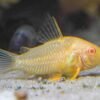-
×

-
×

-
×

-
×
 6X100G Discus Life Garlic Plus Blister – Flash-Frozen Garlic-Fortified Discus Feed, Premium Nutrition for Vibrant Discus Fish, Perfect for Breeding and Community Tanks
1 × £12.00
6X100G Discus Life Garlic Plus Blister – Flash-Frozen Garlic-Fortified Discus Feed, Premium Nutrition for Vibrant Discus Fish, Perfect for Breeding and Community Tanks
1 × £12.00 -
×

Subtotal: £284.89













Emily Carter (verified owner) –
I recently added a group of Corydoras venezuelanus to my 55-gallon planted tank, and I couldn’t be happier with my decision! These peaceful little armored catfish are not only charming but also help keep the substrate clean. After about two weeks, I noticed they actively scavenge for leftover food, which has helped the overall cleanliness of the tank.
Their gentle nature makes them perfect for a community setup, and they get along wonderfully with my tetras and guppies. I’ve had a few different types of corydoras before, but these are definitely my favorite due to their vibrant colors and playful behavior. Watching them interact and dart around the tank is a joy!
The shipping was prompt, and they arrived healthy and ready to explore. One minor concern I had was their initial shyness, but with a little patience, they’ve become more confident. I recommend these lovely catfish for anyone looking to add some lively yet peaceful characters to their aquarium. They’re perfect for beginners and seasoned aquarists alike. I would definitely buy them again!
Emily Carter (verified owner) –
I recently added a group of Corydoras venezuelanus to my 40-gallon planted tank, and I couldn’t be happier! After about three weeks, these peaceful little catfish have truly brought my aquarium to life. Their vibrant colors and playful nature make them such a joy to watch. I love how they scavenge in the substrate, helping to keep things clean while looking adorable! Compared to other schooling fish I’ve kept, these Corydoras are incredibly easy to care for and adapt well to community settings. They get along beautifully with my other fish, and I appreciate how they thrive in well-planted environments.
One minor concern is that, despite their hardiness, they do benefit from soft substrate to protect their delicate barbels. I recommend using fine gravel or sand; it makes all the difference! Overall, I highly recommend Corydoras venezuelanus to both new and experienced aquarists looking to enhance their aquatic community. They truly embody what it means to be a peaceful, engaging fish. I’d definitely buy more in the future!